The SKTCHD AWRDS: The Comics of 2021
It’s time! The main event is here, as the first half of The SKTCHD AWRDS is here, celebrating my favorite comics of 2021. It’s a celebration of the year that was in comics through the prism of the releases that stood out the most to me, and what a year! I went into my preparation for this exercise thinking it was a solid if not unspectacular year and came out of it believing it was one of the better ones in recent memory, with glory at the top and shocking depth to boot.
It was a brutal process getting my list down to just 25 entries but I managed to get it there. To help me get there, I had a few key rules acting as guardrails for my decision making:
- This list isn’t the best, but my favorites. I can say what the “best” is, but I don’t know if that’s necessarily representative of what the actual best is. So instead, I say “favorite.” Deal with it.
- To be eligible, the comic has to have been read by me for the first time this year in a format that was its first version of that format in English, at a very minimum. So reprints or omnibuses or Perfect Editions or whatever do not count. Also trade paperbacks don’t count either if I read the title first in single issues.
- If it’s a single issue comic series, it has to have released three or more issues or completed its run or released the equivalent of three or more issues in terms of pages (i.e. if the first issue is 96 pages or something, it counts) to earn consideration.
That’s it! As The Joker might say, we live in a society, and the society of SKTCHD – at a minimum! – is governed by purely arbitrary rules that make my life easier. Them’s the breaks!
With those rules in mind, I came up with my 25 favorite comics of the year. And then, because I do what I do, I gave each of them awards that I felt best represented what made them favorites to me. If you think it’s a challenge coming up with new fake awards each year, you would have guessed correctly. But it’s part of my process. It’s a blessing and a curse. Let’s get to it, as we celebrate my 25 favorite comics of the year, ordered alphabetically because letters know no biases.
Also: this full version is open to non-subscribers. If you enjoyed my perspective on these comics or this feature at all, consider subscribing to SKTCHD for a whole lot more like it!
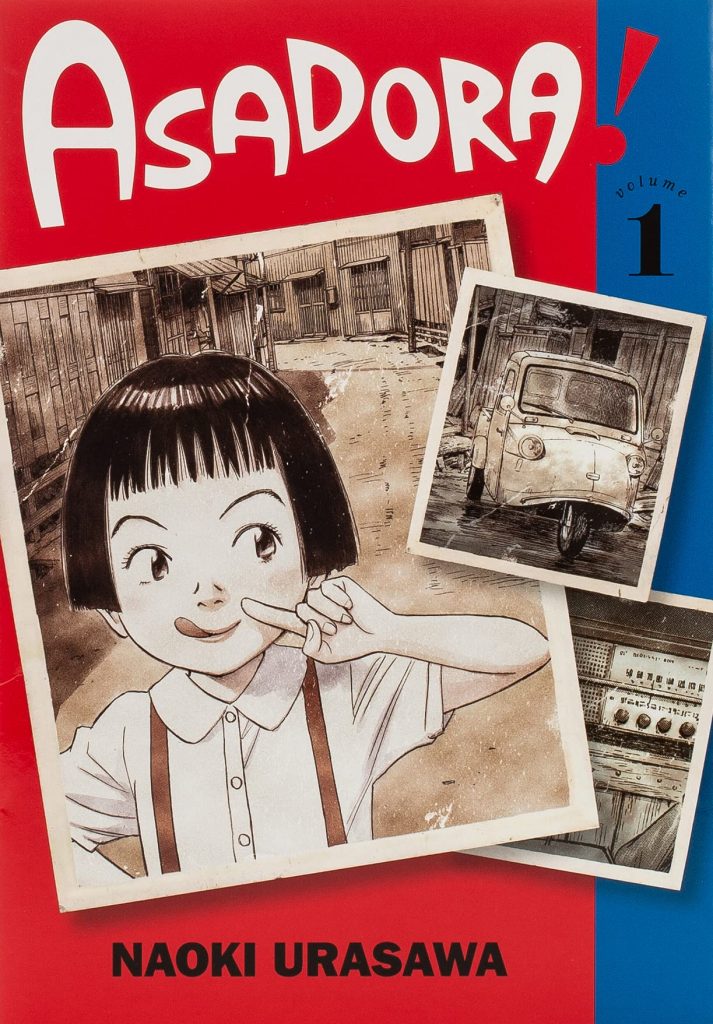
The Master Award: Asadora!
Everything by Naoki Urasawa (and his assistants)
There’s a part of me that believes just saying “look at who made this comic” is a sufficient answer as to why it places here. Naoki Urasawa is truly a master, someone whose work is so monumental that the release of new material is acclaimed in articles by not just people like me, but Parasite’s Bong Joon-ho, who took a break from winning Oscars to celebrate Asadora! himself.
But that’s not what we’re here for, and even the genius that is Urasawa has high points and low points. This is one of the former. I could go on and on about Urasawa’s cartooning, and how his work feels enlivened by the project, with a richness to the visuals that’s even more electric than we’ve come to expect from the cartoonist and his cadre of assistants. Asa Asada, the titular heroine, is already on my shortlist of favorite Urasawa characters, nearing the apex alongside others like Pluto’s Gesicht and 20th Century Boys’ Kanna and Kenji. You can feel the love Urasawa has for the character, a young girl with a life filled with tragedy but an indomitable spirit that leads her to greatness as a pilot and even as a recruit for things well above the expectations of her age.
In many ways, this feels like a sister book to 20th Century Boys, from the enormous threat at its core to its story surrounding major events in Japan’s history. The biggest difference is Asada, as Asa effectively replaces that classic’s ensemble cast on her own, carrying the weight throughout. It results in a purity of experience, a fully invested read that’s both propulsive and emotional, without losing the sense of wonder and fun we’ve come to expect from the master. Asadora! is a dark story, but a joyous one at that, reflecting the effervescent, willful lead at its front and the outrageous talent behind it. I can’t wait for more.
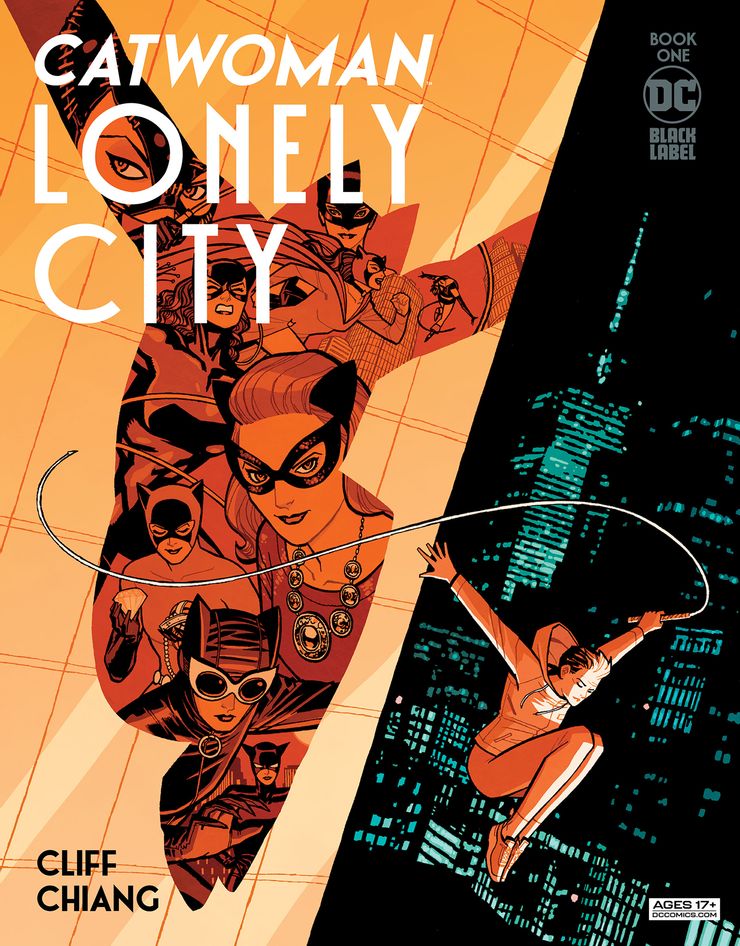
The OGBeast Award: Catwoman: Lonely City
Written, drawn, colored and lettered by Cliff Chiang
Flats by Dee Cunniffe
This is as close to a cheat as I get.
Technically its second issue doesn’t arrive until tomorrow, so it shouldn’t qualify, as it doesn’t technically meet my arbitrary rules yet. However! HOWEVER! I have read the second issue already – I did…a while ago – so it gets through on the “I already read this and it arrives in 2021” exception that you can find in Section 13.2 of your SKTCHD handbook.
That’s not the point, though. The point is this comic is Cliff Chiang to the absolute max, a level we may have thought we had reached before, but evidently we hadn’t. While he didn’t quite do everything – I had to include that Dee Cunniffe flatted this comic, both to highlight his work and because Cliff was so close to doing everything on it – this is one of the rare moments where we get a superhero story that feels as if it’s completely filtered through the worldview of a singular talent. What we get is a Gotham story unlike any other that uses continuity and history in ingenious ways, deploys characters in previously never-before-seen roles (shouts to Killer Croc, the true killer), and acts as the spiritual and even literal follow-up to the great Darwyn Cooke’s work with Selina Kyle. It’s, in short, a masterpiece in the making.
One thing I love about the book in particular is how Cliff Chiang, writer, lets Cliff Chiang, artist, take the lead so often. Silence is one of the most underrated tools in comic craft, in my mind. If deployed properly, it can elevate the emotions of the reader while immersing us deeper into the story. If used too often, it can feel spare, losing us in the process. There’s a fine line there. Chiang knows when to let the art do the talking, walking that line ably, hitting us with heavy beats that require little more than a look or Kyle’s analysis of what happened to her city. It’s electric work while being subtle throughout. That’s another tough balance. But Chiang’s just that good.
That’s how good Catwoman: Lonely City is throughout.
And I can’t even talk about my favorite part yet, something alluded to in the award this comic receives! I can’t wait for you to read issue two. It’s so dang good.
In case you’d like to hear more about this book, Chiang recently appeared on Off Panel to talk about the series. You might dig it.
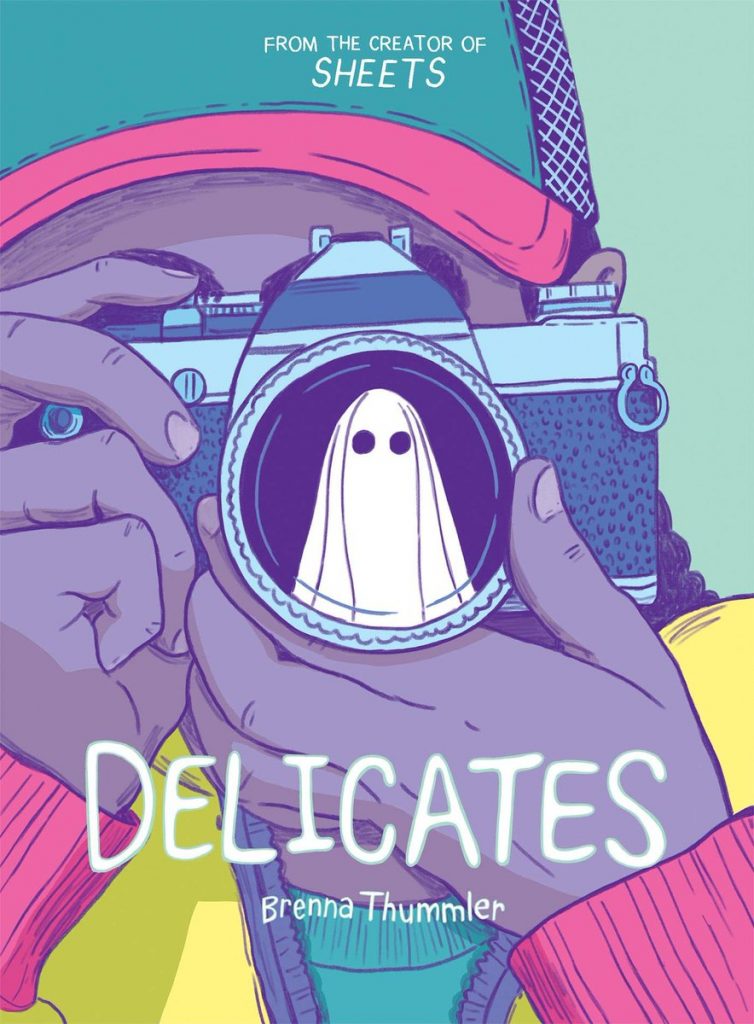
The Wunderkind Award: Delicates
Everything by Brenna Thummler
You can tell when you read Brenna Thummler’s work that she didn’t grow up worshiping comics.
I don’t mean this in a bad way. It’s just you can sometimes tell when someone has read a million comics and when they haven’t. The former often can make great comics, but you can almost see in their execution that they have guardrails on their approach, as if there are rules they have to follow because that’s what everyone does and did before them. The latter can sometimes lead to some discomfort at figuring out what works and what really doesn’t, but it can lead to some unconventional, winning choices as well.
That’s Thummler’s world. You get the feeling every choice she makes isn’t because she saw it once, but because it just feels right. There’s an instinctual nature to her work that makes it feel atypical amongst its peers. Beats that are held a little longer than you’d expect. A character being placed in a different spot on the page than you’re used to. Pages placed simply to execute scene changes. Her valuation system is completely different than most of her peers, and it’s because she’s newer to the medium than everyone else. Not everyone can thrive in that way.
Thummler does. I read her work and it feels refreshing, vibrant, and smart, with Delicates being a graphic novel that exclusively could come from her worldview as a person and as a cartoonist. The story of Marjorie Glatt, Wendell, and Eliza Duncan dealing with both the harsh realities of high school and the unrealities of the middle character’s situation has a universality to it because of Thummler’s fierce talents as a cartoonist, and it has its completely own feel for the same reason. Thummler’s a unique talent with a background wholly her own, resulting in execution that’s similarly individualized. The reflection of a prodigy just tapping into her gifts, Delicates builds on the greatness of Sheets, and taps into some truly high highs in the process.
I talked with Thummler about her art and process as a cartoonist earlier this year on SKTCHD. You might enjoy it.
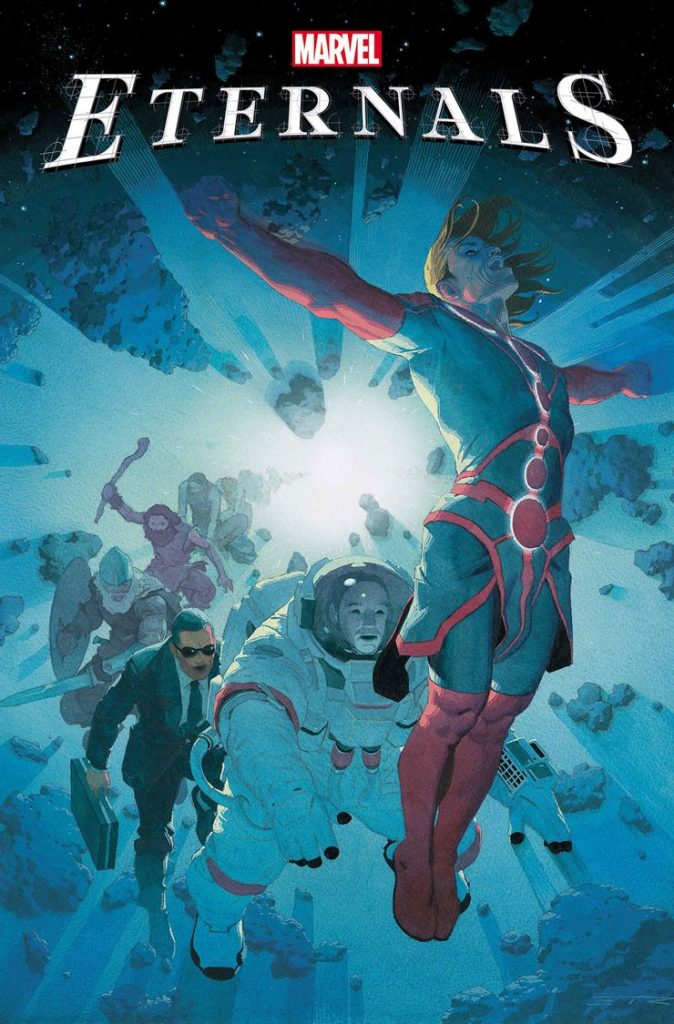
The Superhero Book of the Year Award: Eternals
Written by Kieron Gillen
Line art by Esad Ribic (with one-shots by Dustin Weaver and Kei Zama)
Colored by Matt Wilson
Lettered by Clayton Cowles
I’ve written and talked about this book a lot this year, but it’s for good reason: Eternals is consistently the best superhero comic on the market, in my opinion. That’s at least in part because of how it doesn’t always feel like a superhero comic due to the approach of its creative team. Everyone involved feels as if they’re leaning into the right answers for the book regardless of where superhero answers normally lie. The Eternals historically struggle to connect with readers? Sprinkle in some levity and add some emotional heft to their eternal nature. Dealing with an audience with a mixed bag of awareness about these characters and this world? Leverage data pages and one of the most fun narrators in comic history. Have an artist that’s essential to the book but need to buy him time without wasting the time of readers? Work one-shots into the structure that expand the world but don’t take away from the central story.
It’s a fizzy blast of blockbuster energy, with incredible art and exceptional character work. But the thing that separates it from the pack the most is its intelligence. Each facet is so smartly done and executed with a clarity of vision we rarely see in any comic, let alone a superhero one. It reminds me of an old Gillen-ism, the idea of the faux cartoonist, in which each member of a creative team works together so well you forget its a multitude of separate talents onboard. It’s a singular voice delivering a singular vision. A Uni-Mind, if you will. That’s how Eternals reads. It’s a superhero comic that is its own thing thanks entirely to a creative team with a rare level of cohesiveness to it, always looking to find the right answer regardless of its roots.
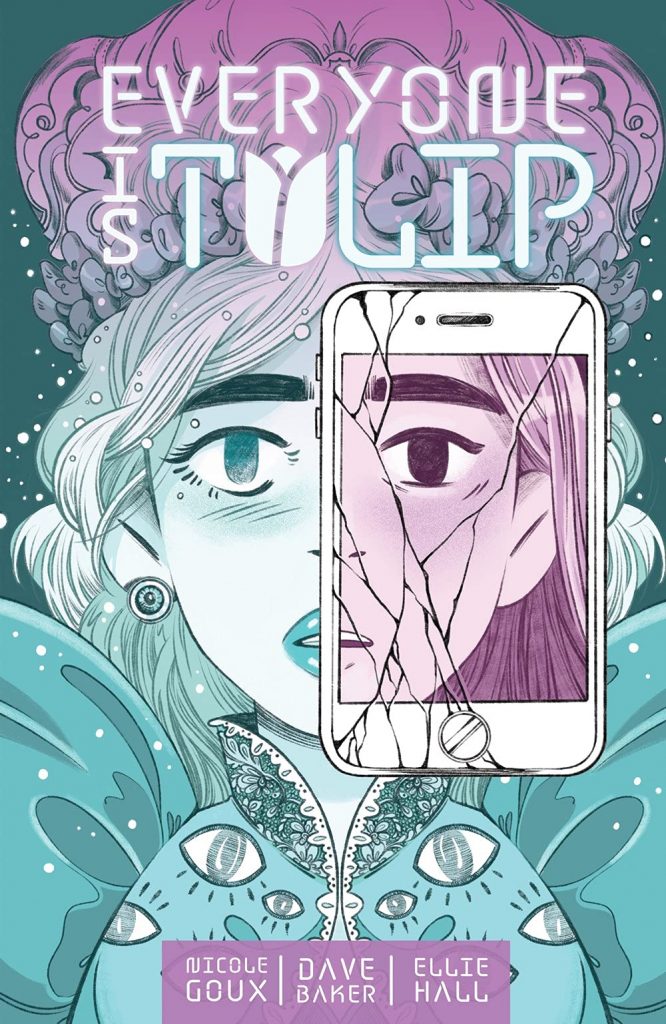
The Modern Living Award: Everyone is Tulip
Written by Dave Baker
Line art, co-colored and lettered by Nicole Goux
Colored by Ellie Hall
It’s very easy for stories that deal with modern trends and tropes to feel fraudulent. There’s always a bit of a “how do you do, fellow kids?” to it, as if the creators are trying to seem hip and cool not because they are, but because that’s a vibe they’re trying to sell. It can kill a comic if you lean in that direction and you fail to execute it properly. That’s why something like Everyone is Tulip, a graphic novel about a young woman named Becca whose rise to fame comes thanks to a toxic artist and his viral vision of turning her into a YouTube persona known only as Tulip, can feel like a high wire act. Move the levers too far in one direction and it’s over the top. Go in the other direction and it feels toothless.
The good news is, the creative team of Nicole Goux, Dave Baker and Ellie Hall adeptly walk that line as well as anyone I’ve seen in comics, crafting a biting, incisive look at the Venn diagram at the center of internet-based fame and identity. Perhaps their ability to avoid the similar pitfalls is tied to the fact they take dead aim at the fraudulence of the whole thing, as they examine the seductive, transformative nature of fame in the social media era. It’s all fraudulent! That gives a lot of meat for them to chew on, and boy do they.
Goux particularly nails it, as her art is the tie that binds throughout. Goux and Baker have worked together a lot, and they clearly have a sense as to when the art can take the lead above all. Doing so allows for us to connect more significantly with Becca’s experience and the vapidity of personal brands, all shallow swipes and taps for that dopamine fix. It also allows for the read to have a universal, mirror-like element to it, as it can make us reassess our phone obsessions and worship of influencers. That’s essential to the success of this exceptional release.
Also, crucially, I must mention the book’s ending. While it isn’t my absolute favorite comic of the year, it very well may have my favorite ending of the year. It’s one of those endings that could feel sudden or even random in the wrong hands, but with these team on it, it’s equal parts gut punch and belly laugh. It’s the bow on the gift that is Everyone is Tulip, bringing the whole thing together and leaving readers thinking of it for days, weeks, and months afterwards.
Goux and Baker came on Off Panel earlier this year to discuss Everyone is Tulip. If you enjoyed this comic and want to hear more, that one is for you.
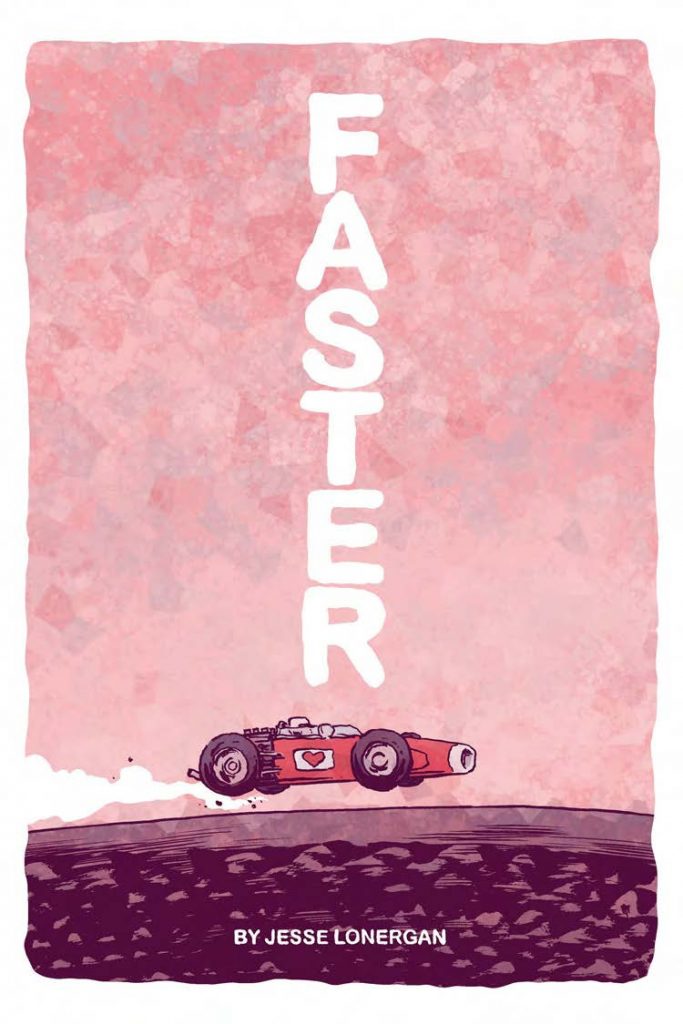
The NOS Award: Faster
Everything by Jesse Lonergan
There’s something to be said about a comic that feels completely unlike anything I’ve ever read. And there’s something else that can be said about a cartoonist that continuously finds ways to deliver those stories. That’s Faster and that’s Jesse Lonergan exactly. While the narrative of this 48 page high-end zine release (or whatever you want to call it) is slight, it’s not even about that as much as it is the experience. It’s about race car driving, and the showdown for the championship between the 5x World Champion and the 5x runner-up, as well as the colorful cast of drivers that surround them. But like with Formula 1 racing or other top level driving, it ends up being about the immersive drama of it all as much as it is about who wins or loses.
And in that regard, Lonergan is unsurpassed. Using hyper-paneling and an eye for detail that’s beyond compare, Lonergan’s storytelling takes us behind the wheel and on the track as all the racing and danger takes place. You can feel the energy in the race, the desperation of the drivers, and touch and go nature of the controlled chaos of this experience. All of the narrative tricks the cartoonist used in last year’s Hedra are evident here, but deployed in a way that makes everything feel smaller, more intense, more personal, more everything. By the time it all cools down, we’re left wondering what happened like the champion who stands alone, but in the very best of ways.
Faster is less a comic and more an experience. It’s a showcase for Lonergan’s remarkable talents, a singular vision from a singular talent, and one that feels as explosive and revved with energy as the prodigious gifts the cartoonist brings to the page.
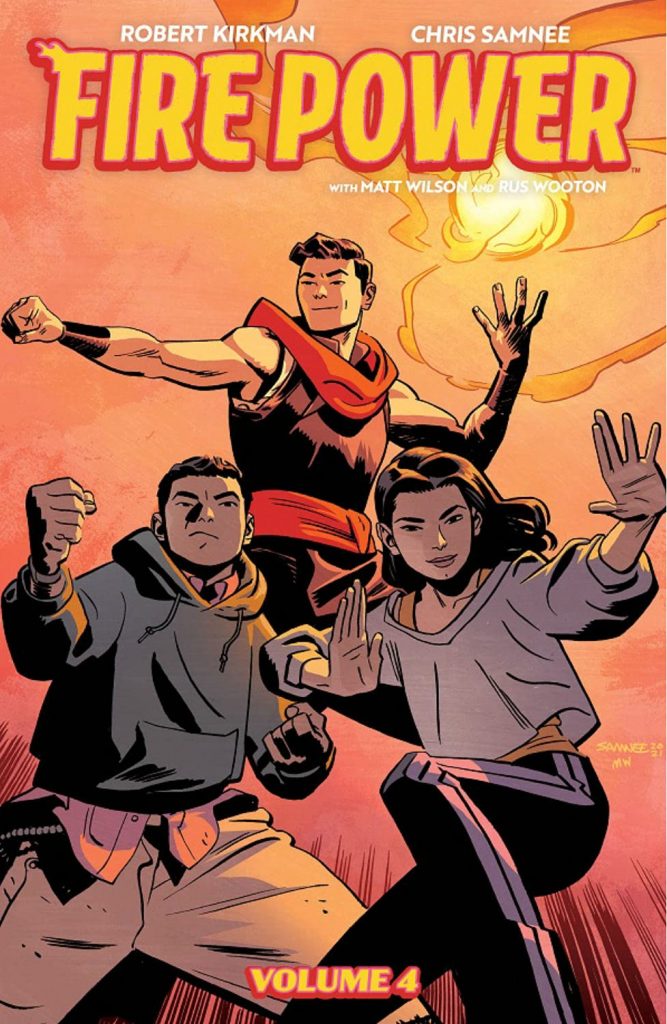
The Pure Fun Award: Fire Power
Written by Robert Kirkman
Line art by Chris Samnee
Colored by Matt Wilson
Lettered by Rus Wooton
Some comics challenge you as a reader. Some make you see the art form differently. Some you read and think, “This is going to change the medium forever.”
And some are just fun as hell. That’s Fire Power, the Skybound series from Robert Kirkman, Chris Samnee, Matt Wilson and Rus Wooton. It’s on my shortlist of the finest superhero comics of today, simply because – like with Invincible before it – it captures the apex of Marvel’s history by tapping into the big, crazy superhero-like fights, the sweeping drama, and the personal lives that make those beats so relatable. It was originally (and endlessly) compared to Iron Fist, but honestly, it’s almost more Fantastic Four, featuring an adventurer father and the family that comes with him to wildly different, otherwise unknown parts of the world that are filled with equal parts wonder and danger. It puts family first, and that makes it pop in a way the Iron Fist ripoff many expected wouldn’t have.
Kirkman excels at that type of story, a sweet spot that feels less like cover album than him making something new out of something old. But reaching its potential comes down to finding the right partner to give all the beats the enormity and weight they require. Surprising no one, Samnee is an effective partner in that regard, with the artist and his long-time partner on the color side of the world, Wilson, separating this book from others that might take on a similar formula. Samnee’s character acting is on full, glorious display throughout, whether it’s Wei Lun squaring off against a particularly agile snake or a trio of dejected villains coping with the rigors of economy class on a flight. Put the wrong artist on this book, and it feels empty. Put Samnee on it and it feels electric and impossible to not enjoy.
Sometimes you want a comic to push you. But other times, you just want to have a good time. The latter is Fire Power, through and through.
I talked with Samnee about this book quite a bit in a podcast from earlier this year. You might dig it if you enjoyed Fire Power.
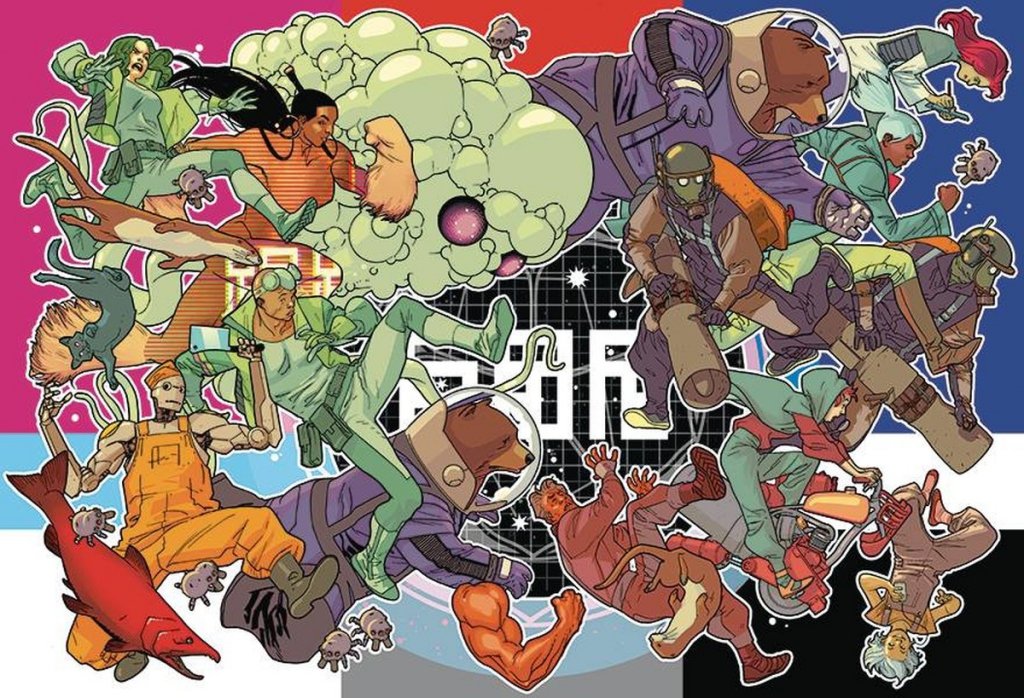
The “Uh Oh!” Award: Grass of Parnassus
Everything by Kathryn and Stuart Immonen
Grass of Parnassus reminds me of Sealab 2021.
More specifically, it reminds me of an episode called “Vacation,” in which Dr. Quinn from the crew being forced to take a staycation on the titular Sealab, with the bulk of the episode taking place outside of his room as the rest of the crew attempts to figure out what he’s actually doing. Each time a conversation takes place between the cast, outlandish ideas are introduced, triggering a sequence of characters saying “Uh oh!” for a minute and a half plus. It’s basically a single joke repeated over and over, but done in a way that becomes progressively more insane and hilarious, highlighting effectively every member of Sealab and its larger cast in the process.
That’s kind of what happens in Grass of Parnassus too. It’s a look inside a perpetually malfunctioning spaceship/chunk of rock, and the colorful characters – astronaut bears! talking fish! an arm! space otters! – that reside and work on this disaster/method of conveyance. Like that episode, it’s a tour of these bonkers figures, with Kathryn and Stuart Immonen showcasing each at a breakneck speed that adds to the lunacy. Like that episode, it’s hilarious and a little crazy. But unlike that episode, there’s something soulful and unexplainably weighty about Parnassus, achieving a depth that Sealab never dared try to achieve.
This comic originated as an Instagram comic, and it’s been compiled into a gorgeous, one-of-a-kind final graphic novel release by Chris Pitzer and AdHouse Books. The roots of Instagram are present, though, as the square panels and sequential collection of a series of standalone posts add to the “Uh oh!” like energy this book has. But read in its totality, you start to see the beauty of each of these shared relationships, and what makes this gaggle of woebegone workers stick around with this janky, disastrous ship: the people that make it special, even if they’re similarly janky and disastrous in their own ways.
Stuart’s art is the tie that binds here. While the writing and ideas and structure of this are exceptional, with Kathryn’s contributions deserving all the kudos in the world, Stuart brings the mad, electric energy of the ship and its denizens to life while giving it the necessary weight to feel real. It also elevates much of the humor, as his character acting and vibrant colors make us feel everything to the absolute max. Stuart’s my favorite comic artist, and this is him delivering the very best version of this comic and its visuals. I could not ask for more.
Interestingly, this work doesn’t just feel like a collaboration between the Immonens as much as it does one between them and everyone they’ve ever met or known. Going through the splendid backmatter in the AdHouse release, you learn details like how a sequence is derived from a voicemail Marvel editor Nick Lowe once left for them, and how one visual comes directly from a photo cartoonist Chip Zdarsky sent the pair. This is Kathryn and Stuart doing them to the best of their abilities, but also deriving the essence of this insane, splendid world from the crew members that populate their own world. It makes for an unusual, remarkable, hilarious read, and one that’s unlike anything else you’ll read this year – or really any year, for that matter.
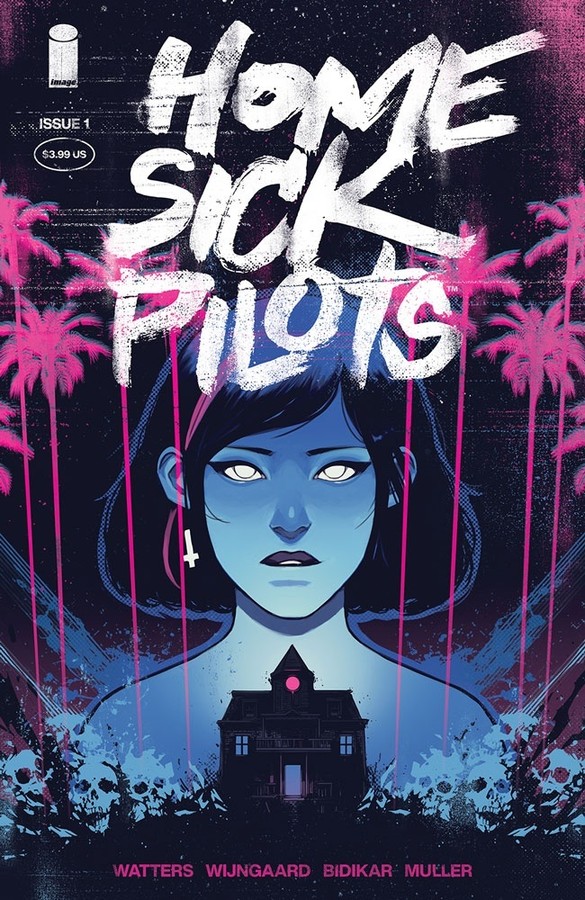
The Voltron Award: Home Sick Pilots
Written by Dan Watters
Line art and colored by Caspar Wijngaard
Lettered by Aditya Bidikar
Designed by Tom Muller
One of the things I find the most interesting about Home Sick Pilots is how the line between the roles of the creative team can feel pointless. Not that each member of the team doesn’t execute their respective tasks with style and panache. It’s just that there’s a fluidity and collaborative feel to each that makes the whole feel greater than the sum of its parts.
Whether it’s visuals that are more derived from the writing of Watters and executed by Bidikar’s lettering or the heart Wijngaard imbues the characters with, the clean line of attribution between the creative team isn’t so clean here. It’s about a team acting as one and achieving more because of it. That’s why they get The Voltron Award. Like the houses infused with ghost power in the book that can become walking, battling kaiju in their own way, this is a quartet of the best in the business working perfectly in lockstep to execute moments both big and small in the series.
If the first volume was all about the ghosts that always seem to haunt you, then the second looked at how inescapable those can be, and how sometimes the only answer is to confront them. It’s a haunting, thrilling read, and one that’s elevated past a solid concept into something more. It found Home Sick Pilots taking the leap from good to great, with its cast becoming all the more fascinating and relatable, and the world continuing to reflect the fractured reality we live in, even if its definition of mobile homes is slightly different. This is one of the smartest, most potent reads from Image right now, and something that reflects the standards and ideals of the publisher to a tee. Big fan.
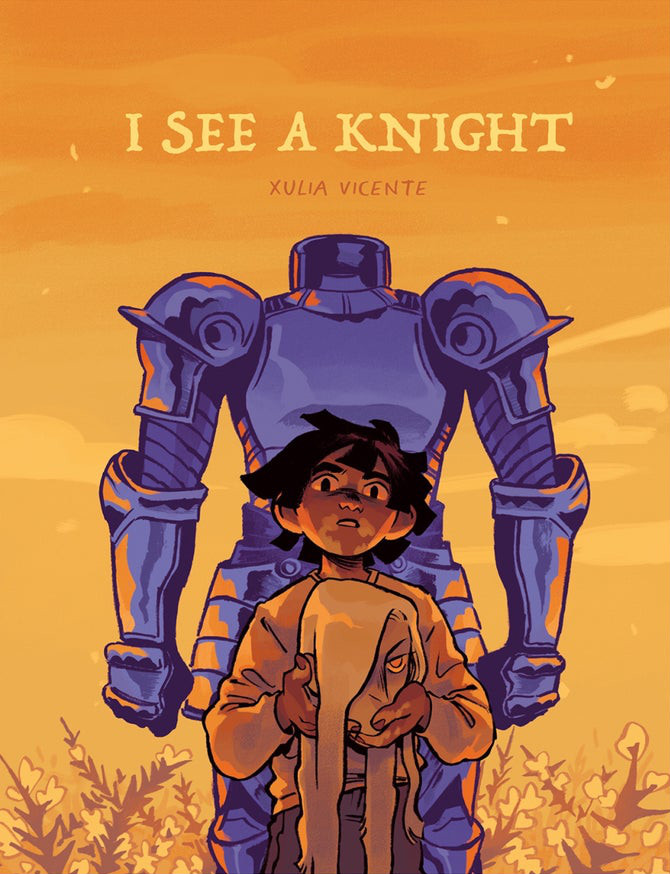
The Emotions Award: I See a Knight
Everything by Xulia Vicente
In some ways, what this book is about is right there in the title and on the cover. It’s about Olivia, a young girl at first, who sees a headless knight following her. Sierra, the knight, proceeds to haunt Olivia’s existence in the sense that she’s always there. In reality, she becomes Oli’s best friend and constant companion, a sounding board and confidant as she ages and begins to figure out who she truly is.
But in reality, it’s about the relationship they form, and how duty continues onwards as we discover who – or what – Sierra truly is. It’s a poignant look at growing up and figuring out who you are, and the heartbreak and catharsis that can come with those ideas. Vicente’s cartooning is exceptional, easily tethering readers to the vibrant, lively Olivia and the guarded, empathetic Sierra through her always effective, often electric character acting. You feel deeply during your read both because of this lovely and sad tale Vicente created but because the cartoonist is so exceptional at bringing its two core characters to life.
And by the time the ending hits, you feel as if you’re ready for the gut punch that’s to come, but you really aren’t. It’s a devastating, poetic beat, one that puts you in the position of both Olivia and Sierra in the moment: happy for your time together, but distraught all the same. I See a Knight is a 36-page emotional rollercoaster, a vibrant read with tremendous production value from ShortBox. It’s one of those reads where you read it and just know how special it really was — or, more specifically to the book, you feel how special it was.
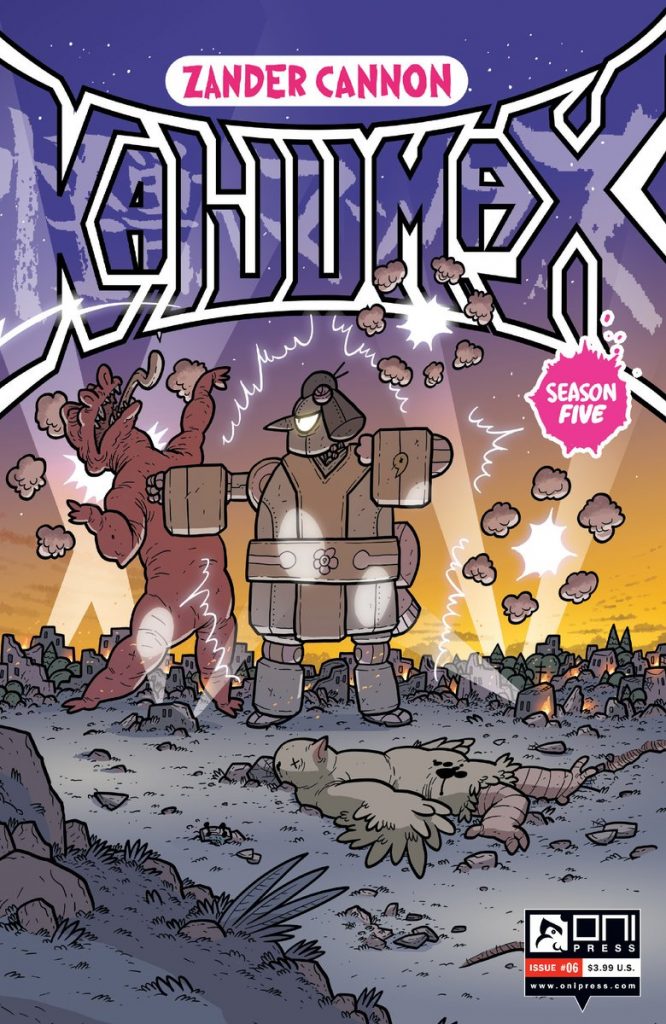
The Moment of the Year Award: Kaijumax
Everything by Zander Cannon (with color assists by Jason Fischer)
I know.
I know.
I’m sure you’re eager to read even more words from me about Kaijumax, Zander Cannon’s long-running (and nearly completed) comic series about kaiju’s lives in a supermax prison (which is a very simplified version of what it’s about while actually being pretty much exactly correct). I’ve noted how it’s favorite comic now and how it’s one of my favorite comics ever many, many times. So I won’t talk about the larger efforts of Cannon and the series this year, which has had five issues drops this year with a sixth arriving right before the new year.
Instead, I’m going to talk about a single issue!
It was the first to arrive in 2021, the final issue of the title’s fifth season. To let you know how much I was destined to like it, Patrick Brower of Chicago’s Challengers Comics + Conversation texted me to see if I had read it the Wednesday it arrived, simply because he knew there was a moment I would love immensely within its pages. I had not. But you know what? He was right. That moment, a beat that felt both destined and perfectly surprising as I read it, was my favorite of the year. It in many ways crystallized everything I love about Kaijumax: the absurdity and poignancy, the darkness and the hope, all depicted by the genius that is Cannon. Kaijumax can be very tongue in cheek, a send up of many ideas that preceded it. But when it wants to punch you in the gut with a moment, it can do it with the best of them. And this one wrecked me, but in the very best of ways. I can still envision the moment in my head immediately, seared in my brain out of perfection.
That’s what Kaijumax is capable of. It contains multitudes, each of which can deliver the best version of the feeling its looking to evoke. It’s going to conclude in 2022 with one final issue. It’d be a real surprise if it wasn’t right back here next year, even with just one issue to its name. I have no doubt Zander’s going to crush it, even if he crushes me – with tears! – in the process.
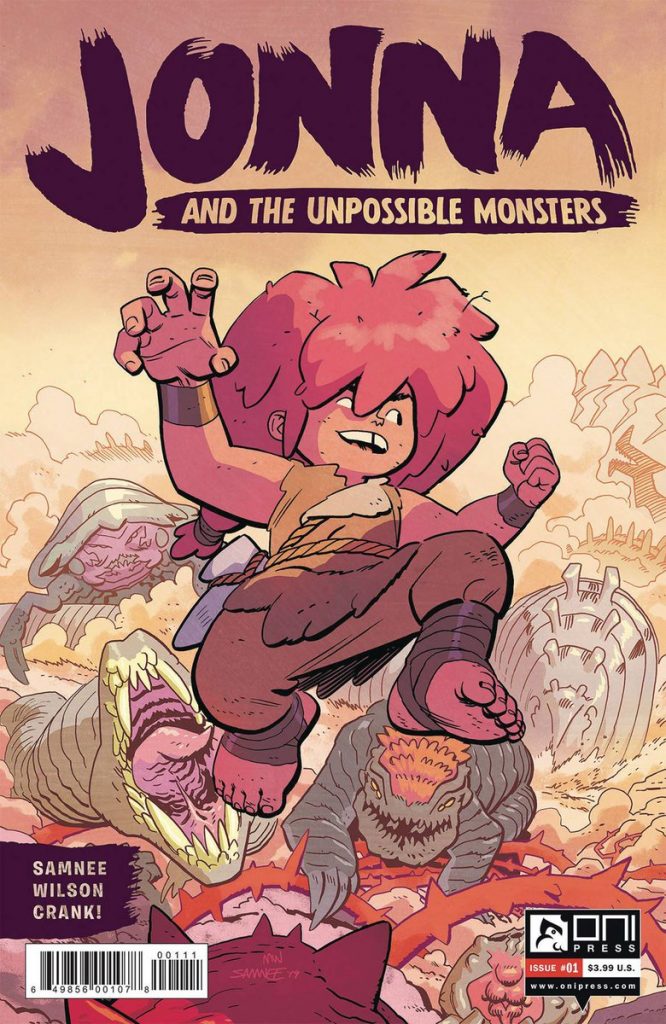
The One and Only Award: Jonna and the Unpossible Monsters
Written by Chris and Laura Samnee
Line art by Chris Samnee
Colored by Matt Wilson
Lettered by CRANK!
There are many things I appreciate about Jonna and the Unpossible Monsters, the Oni series about two lost sisters in a monster-filled world trying to find their way (and answers), but one aspect I appreciate about it to perhaps an even higher level is how it feels as if it could only have come from the Samnees. More specifically, how it could only have come from Chris Samnee. Sure, there are influences present – we talked on Off Panel about how one particular page turn evoked The Wizard of Oz – but it never feels like Jonna owes anything to them. When you read it, you know there’s one and only creative team that could have made this book, and it’s the one that’s actually making it.
It gives the book a vibe that’s exclusively reflective of them and their storytelling values. The pacing and scale and character work and energy are dictated purely and completely by the team, and that makes this stand apart from any other Samnee book for that reason. As much as I like Fire Power, you can feel the difference between this and that as you read it, and how much joy Chris gets out of bringing this book and world to life. I’m sure he enjoys both, but this feels different, if only because it’s purely coming from him, his family, and some of his closest comic compatriots. It feels like destiny being realized, something the team was meant to make as much as they simply wanted to create.
Also: this comic is so fun! I don’t want to underrate that aspect. You couldn’t ask for a much more smartly crafted, jubilantly delivered blast of fizzy energy out of comics than this one. It’s a delight, and one of the true treasures from this year in comics.
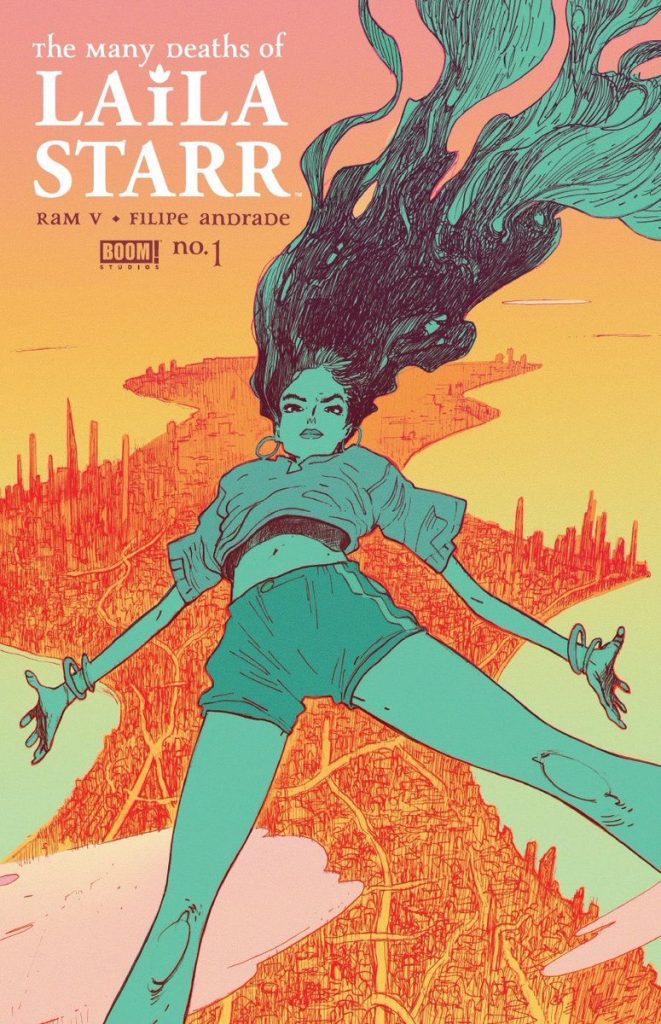
The Ascension Award: The Many Deaths of Laila Starr
Written by Ram V
Line art and colored by Filipe Andrade
Lettered by Deron Bennett
This story about the fall of the Goddess of Death on the occasion of the birth of the person who will solve the problem of death also marks an occasion of ascent. While I’ve liked many comics by the creative team, The Many Deaths of Laila Starr saw Ram V, Filipe Andrade, and Deron Bennett elevate themselves into rarefied air, achieving greatness on a level that truly surprised me as a reader.
Not that they weren’t capable of it. This is an incredibly talented trio of creators. But there’s something unbelievably pure and perfect about Laila Starr, a poetic beauty mixed with a real sense of the moment and an electric level of entertainment that we rarely see fused together in stories. Truth be told, Laila Starr exists on a tier separate from the rest on my list – along with three others, it’s one I’d call a classic of its form – and it’s because this five issue mini-series is simultaneously a collective of five individual issues that tell singular, potent tales and the continuing tale of two stars in orbit of one another, burning bright. Making individual issues stand out alone while also getting them to work together can be terribly difficult to do. Too far on the former side and they can feel disconnected. Lean towards the latter and it just feels like you’re rushing through the micro to favor the macro. Laila Starr balances that perfectly. Its whole hits because the individual entries so effectively build the themes and feelings of the titular character’s journey that by the time you reach the end you’re destroyed and inspired by where you’re left.
This series is an inspired bit of collaboration. I’d say that it feels like the apex for each creator so far in their respective careers, with the caveat that I haven’t read everything each has done. That’s because they elevate each other, taking moments that rise or fall depending on the execution of the craft and finding the ceiling of its potential in the process. Andrade in particular feels energized here, with the bustling, relentless energy of Mumbai and the often elegiac (yet hopeful!) emotions of the story pairing perfectly with the artist’s linework and colors.
I do want to note, though. One thing I feel – and this could be completely unfounded – about Ram V as a creator is he seems to be an unusually generous writer. While many writers will insist that they do what they can to write specifically for their collaborators, it’s not always possible. But Ram always seems as if he does everything he can to find the right ways to put his partners in a position to succeed and achieve the highest heights in their work. That certainly happens here, and it’s a case of the sum of the parts being far more than what they started with.
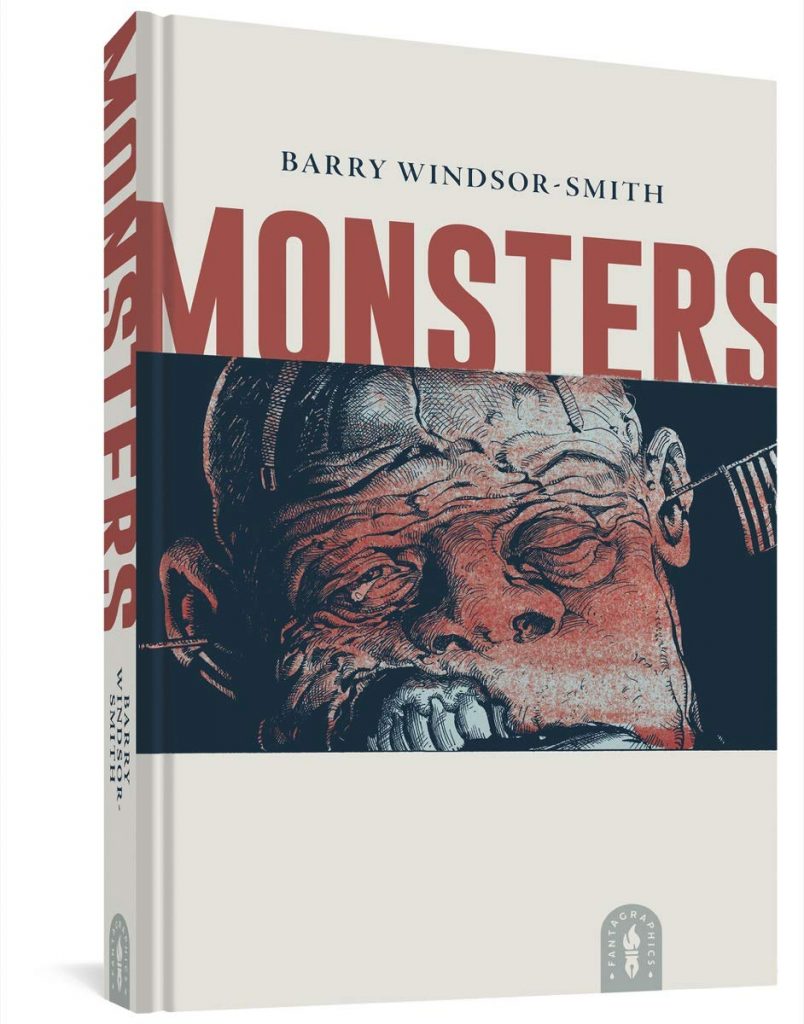
The Decades in the Making Award: Monsters
Everything by Barry Windsor-Smith
Did you know that Monsters took Barry Windsor-Smith around 35 years to complete?
I’m guessing you did, because it’s the primary thing I see anyone say about the comic. I found that fascinating before I read it, as there had to be more to say about it, right? That’s an interesting factoid, but it’s a monster book from a monster talent. It struck me as odd that I heard little else about it.
And then I read it and understood.
It’s a remarkable comic, but also one that is difficult to diagnose after you read it. Here’s the gist of what it’s about: it all centers on Bobby Bailey, maybe one of the most woebegone characters in the history of fiction, and how his entire life led to him becoming a monster surrounded by even more monsters. It’s also about fate, about faith, about how our actions can affect everyone’s lives, of the destructive power of war, of the destructive power of family, and of one poor kid whose life was destroyed by the return of a person who was meant to care for him the most. While it starts in 1964, the bulk of the story takes place during and in the wake of World War II, where the bulk of the most haunting, crushing moments of the book happen. It has maybe the longest continuous stretch of flashbacks of any comic I’ve ever read, with each of these acting as Russian nesting dolls, with flashback hiding within flashback hiding within flashback. It underlines how no devastating moment in the present is a product solely of that time; they’ve always been long in the making.
I cannot understate this: this is probably the most stressful and intense comic I’ve ever read. You don’t enjoy this comic as much as you survive it. I don’t mean that in a bad way. It’s just what it is. That it works at all speaks to Windsor-Smith’s remarkable talents, as the visuals – all pen and ink, black and white – stagger and haunt you in equal measures. There are long sections of the book that are seemingly handwritten diary entries by Windsor-Smith stepping in for one of the characters, and the level of care and meticulousness the cartoonist gives this book delivers the heft and weight of every moment. The term magnum opus gets thrown around fairly easily, sometimes sarcastically. But this is truly that: a life’s work, an effort that could only come from one person and one person alone.
Maybe the most astonishing thing about the book is how much it makes you feel. While the bulk of the cast is, in fact, a monster, what Windsor-Smith is able to do is help us understand them, even if we still hate them for what they do. There’s a pervasive sadness to it, a tragedy you feel the weight of both because of Windsor-Smith’s craft and because the book itself is nearly 400 pages. Monsters is truly an achievement, and one you should read. Probably once, though. Rereading this does not seem fun, even if I’m glad I read it the first time.
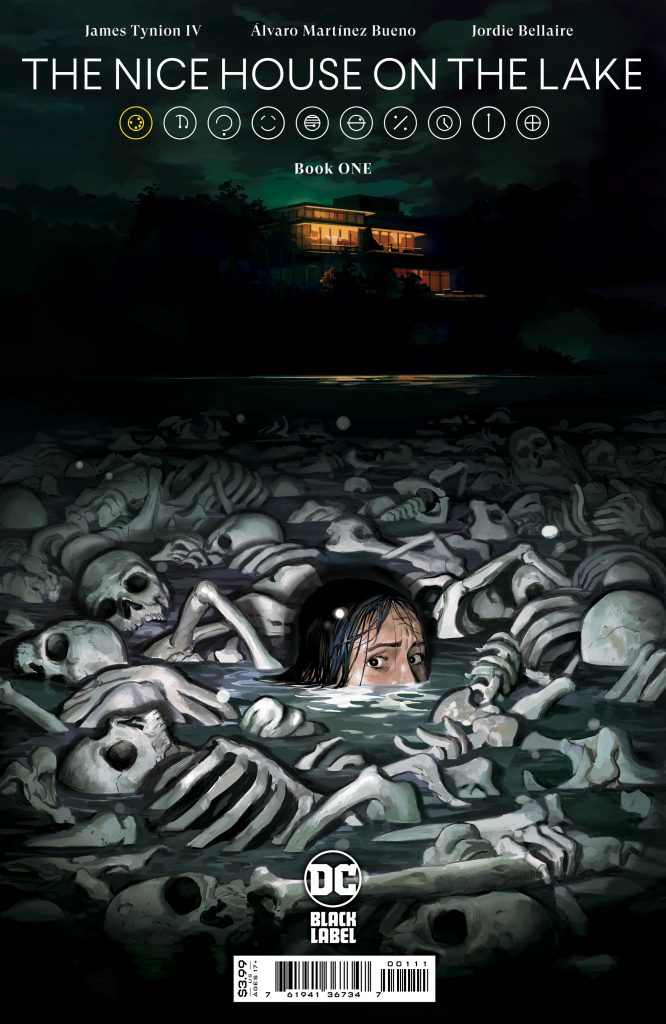
The Precision Award: The Nice House on the Lake
Written by James Tynion IV
Line art by Alvaro Martinez Bueno
Colored by Jordie Bellaire
Lettered by Deron Bennett
The Nice House on the Lake, by nature, is a chaotic comic. It’s about a gaggle of people trapped in a secluded, gorgeous home (and the surrounding area) as the world ends around them. There’s more to it, but that’s the relatively spoiler-free version of its premise. And it turns out that’s a good way to set up your cast for high stress, high anxiety lives, with each corner offering new drama and horrors. Chaos reigns in The Nice House on the Lake.
Paradoxically, one of the things I love the most about it is how orderly it feels as it bathes in that chaos. The creative team of James Tynion IV, Alvaro Martinez Bueno, Jordie Bellaire, and Deron Bennett have crafted a comic that feels almost as if they’re less creating it and more perfectly recreating something that already happened because of how precise it feels in its storytelling and idea creation and execution. It all jives together in perfect synchronicity, from the design of the home and the personalities of the cast to the symbols that represent each of them and the variety of pages and tactics that are used to deliver information in condensed yet fitting ways. It meshes together with an elegant ease that’s rare to see. If it had a theme song, it’d probably be “Everything In Its Right Place” by Radiohead simply because it is just that (also the vibe of that song totally feels right for the book).
One thing I’ve applauded Tynion in the past for is his unique gift of borrowing the abilities and strategies of other comic writers from the medium’s history and deploying them individually or in concert to maximum impact. I once described him as the comic writer equivalent of DC’s Prometheus, a character that can download the knowledge and skills of anyone he wants with ease. It’s for that reason. This feels like the pinnacle of Tynion’s Prometheus-like gifts, as The Nice House on the Lake is a fusion of the data pages of the Jonathan Hickman era of the X-Men, Brian K. Vaughan’s final pages, Ram V’s aforementioned gifts of helping elevate his collaborators, and any number of other remarkable talents. This isn’t to say he’s a copycat. He delivers each in his own way. It’s just he knows how to pair them together in a way that gets the most of the work, and in a sequence that underlines the precision I’ve mentioned.
That said, as much as I love Tynion’s work, Bueno and Bellaire are the stars here. It’s just electric work from both throughout, with Bellaire’s emotive colors and Bueno’s potent storytelling playing readers perfectly. Precision can be cold without the right partner, and the art team excels at connecting readers to the cast and this world. We feel what they want us to feel, so we feel a lot. Sometimes that’s a good thing, like in issue #4, as Bueno depicts house jokester David and his attempts to bring levity to a dark situation, with those efforts including a perfect recreation of Ferris Bueller’s iconic outfit. Other times it’s less fun, like in some of the more haunting and horrific situations, something the team delivers with equal aplomb.
There’s more to come about this team next week, so I don’t want to go much further. But The Nice House on the Lake is on a modern classic path through six issues thanks to the efforts of its remarkable creative team, and the deft, precise touch they bring to each panel, page and issue.

The Comic of the Year Award: No One Else
Everything by R. Kikuo Johnson
Sometimes you just know with comics, and with R. Kikuo Johnson’s No One Else, a tragicomedy graphic novella about a family in Maui dealing with an immense loss in wildly different ways, I just knew.
“That was the best comic I read all year,” I told my wife after I finished reading it. “That might have been one of the best comics I’ve ever read.”
And that was after one read, a furious experience I took on in the bath of all places. At risk of getting terribly pruny and the bath getting chilly, I read the whole book while enjoying a nice, restful, warm soak, and I couldn’t get out until I was done. Since then, I’ve enjoyed this comic two additional times, with each read adding to my enjoyment and revealing further details and aspects to appreciate. And I must say, it isn’t just Johnson’s impeccable craftsmanship and remarkable storytelling I connect with. It’s a story that speaks to me on multiple levels.
One is deeply personal: I see myself in this story and the experiences within it. More than that, I see truth in the tragedy at the center of it, and how each main character – mother Charlene, brother Robbie, son Brandon, lost cat Batman – responds to it. Truly unexpected death affects each person differently, having a reorienting impact on relationships and identities that’s difficult to explain unless you’ve gone through it. It can fundamentally change who you are, at least for a time, and it isn’t just about being sad a lot. It’s more than that. A foundational shift in who you are, and Johnson absolutely nails that aspect in a way I’m not sure I’ve seen before. 1
Another is Johnson’s execution. It’s brilliantly done, from the format and execution within that to the character work and his approach to color. As we discuss on next week’s episode of Off Panel – Johnson joined me for a chat about the book, as is standard for my favorite comic of the year on the podcast – the format leads to some particularly fascinating wrinkles, especially in how it can often read like a collection of a comic strip no one ever knew existed. While it’s undeniably a sequential story, it’s also one where entire pages or pairs of pages can exist in isolation, vignettes of comedy or sadness that work alone for any one who just happens to pick up the book.
One page in particular, one where Robbie confronts his views on island culture and the hypocrisy at its core before we’re whipped back in a hugely funny final panel, crystallizes everything that’s great about Johnson’s gifts as a cartoonist. The exceptional cartooning on Robbie in the final panel and the tranquil, old-timey helpfulness of the couple in the preceding panel. The format and how Johnson uses it adeptly to set up and execute a gag. How even in the joke there’s weight and volumes said about the character involved with it. It’s just a brilliantly done page in a sea of them.
The final is in how accessible I feel as if it is. It’s tough to tell a story that could work for anyone. I believe Johnson accomplishes that with No One Else. There’s just a welcoming nature to it, from its electric yet simple storytelling to the level playing field it gives the cast so we never take one person’s side over another. It’s the rare comic I feel confident in being able to hand to anyone and that person getting something out of it. It’s about life, and all of the funny, sad, and weird things that happen along the way. It’s also about time, and how it always wins in the end, even if we swear it won’t. More than anything, it’s about being human, and just how messy that can be.
This book is a treasure, filled to incredible depths with exceptional characters, even finer cartooning, and a moment that, as I told Johnson, made me scream laugh from the bath when I first read it. No One Else isn’t just my favorite comic of the year; it’s the best. And I knew it from the moment I finished it.
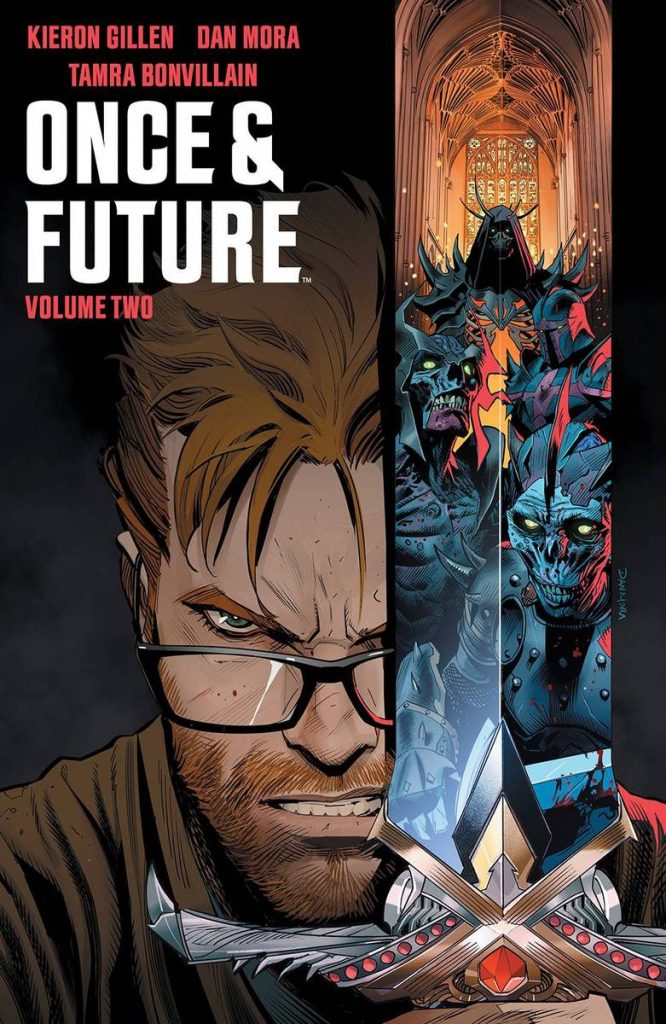
The Popcorn Award: Once & Future
Written by Kieron Gillen
Line art by Dan Mora
Colored by Tamra Bonvillain
Lettered by Ed Dukeshire
I’ve said this before and I’ll say it again: the thing I want from comics more than anything is to be entertained. I’m in the market to have fun, and comics at its core can – can – be one of the most entertaining mediums there is. It’s just sometimes it isn’t used in that regard. But, to use modern phrasing, the creative team of Once & future understood the assignment.
Because this book rules.
I know saying something “rules” isn’t classic, effective comics criticism language, but that’s not really how I roll anyways. More than that, it’s absolutely true. Once & Future is one of the most entertaining, blockbuster adventure comics in the market right now, with everything in it being big. Big monsters! Big laughs! Big action! Big familial troubles! Big thoughts on the impact stories can have on our lives, from Arthurian legend to what we tell each other as individuals! Okay, that last point doesn’t fit the rapid fire scheme I was going for, but it’s still there. Once & Future is completely, shamelessly, delightfully, a popcorn book, something best enjoyed like a rollercoaster rather than a comic: just give up and enjoy the ride.
A huge part of that is Dan Mora and Tamra Bonvillain. These two are, save for maybe another Kieron Gillen pair of compatriots in Jamie McKelvie and Matt Wilson or Wilson and Chris Samnee, maybe the most in-sync line art/colorist combination in all of comics today. For us to buy in to all of the big insane events of this book, you need the right art team. And there are few that are more right than this pair, as Mora and Bonvillain somehow simultaneously complement and elevate each other. There are few better looking comics than this, from the big moments to the – and these exist, I promise – small.
Gillen should obviously not be underrated, and it’s worth noting that this, like any good popcorn story, does have emotional heft to it. Action without reason or emotion is weightless. You need a reason to care. And at the core of this big, bonkers blockbuster about the secret side of the world that finds fable folk like Beowulf and Gawain coming into our world before a family of monster hunters stop them is that one crucial word: family. While it’s about nationalism and populism and the impact telling tall tales can have on our world, more than anything, it’s about our relationships with the people closest to us, and the cost that comes with those.
It rules in that way too. It’s not just entertaining, but smart, both in the brain and heart. We could use more comics like Once & Future, but until we do get more of them, I’m happy to have this one at the very least.
Also, I just talked to Gillen about this on Off Panel. You might enjoy that conversation if you enjoy Once & Future.
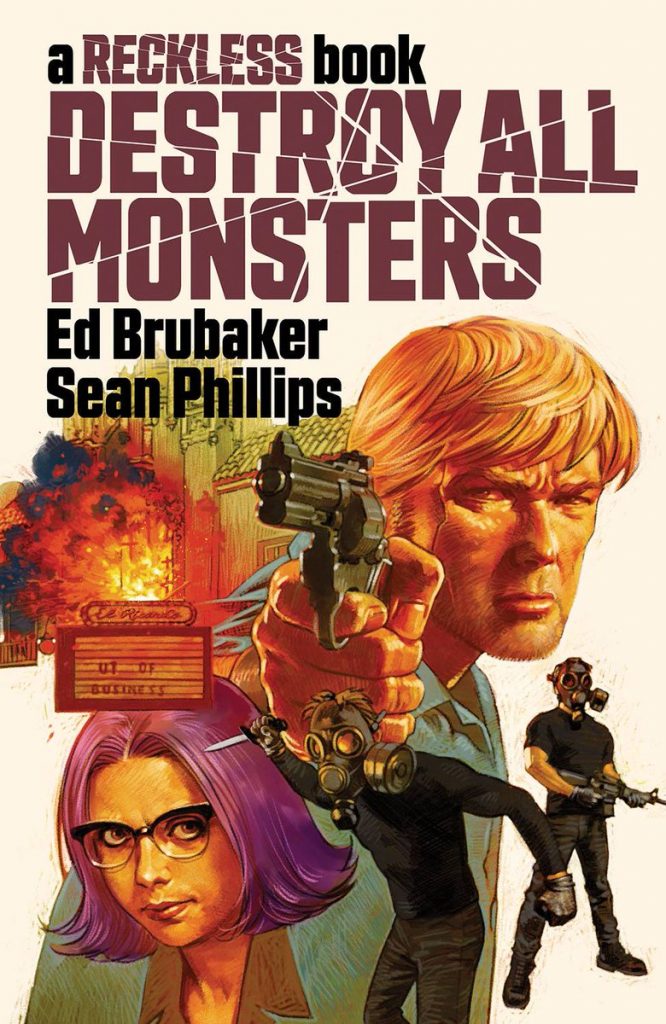
The Function Follows Format Award: Reckless (Series)
Written by Ed Brubaker
Line art and lettered by Sean Phillips
Colored by Jacob Phillips
It can be difficult to compliment Ed Brubaker and Sean Phillips’ collaborations at this point, because it can feel I’ve done it so many times that the point still stands. They’re very good at comics, and particularly good at the type of comics they do, which are probably most aptly described as “Brubaker and Phillips comics.” But they earned a spot on my list, as per usual, so compliment I must.
Reckless – their series of standalone but complementary graphic novels about Ethan Reckless, a freelance tough guy who is like a small town doctor in that his rates rise or fall depending on who he’s working with, and unlike a small town doctor in that he inflicts harm upon people – is excellent. Both releases this year, Friend of the Devil and Destroy All Monsters, showcased everything we love about the pair’s work together, as well as Jacob Phillips’ exceptional colors. But the wrinkle it introduced is related to the format and structure of their approach. While they’ve worked in original graphic novels before with Pulp and My Heroes Have Always Been Junkies, the interesting part about the Reckless series is how they’re both standalone stories and not, an interesting space in comics that is rarely explored. These books are as big as you want or as small as you want simultaneously, and Ethan Reckless can be a one-shot badass with a heart of gold or someone whose life you follow for an extended period. And that provides the team some interesting, fertile, unusual ground to explore.
They do a lot with it. It feels as if they’re freed by this new format, and that they’re able to get to some new depths and explore slightly different approaches in the process. While it’s still the typical and expected outrageously exemplary work we expect from the team, it also tastes a bit different, a new flavor that spices up the experience and changes its complexity in the process. Destroy All Monsters was a highlight in particular there, as the team feels enlivened by Ethan’s sidekick Anna being elevated to almost co-lead status. They’re evolving as they feel like it, and while Anna’s rise might have always been an essential part of the plan, the complete-but-continuous nature of the format reads as if it’s an environment that allows for experimentation of their approach while perfecting it at the same time. So, sure, they’re difficult to compliment after eternally being excellent. But Reckless is proof that even wily veterans like Brubaker and Phillips can keep evolving, finding new ways to do things within a well-tested approach. I love to see it.
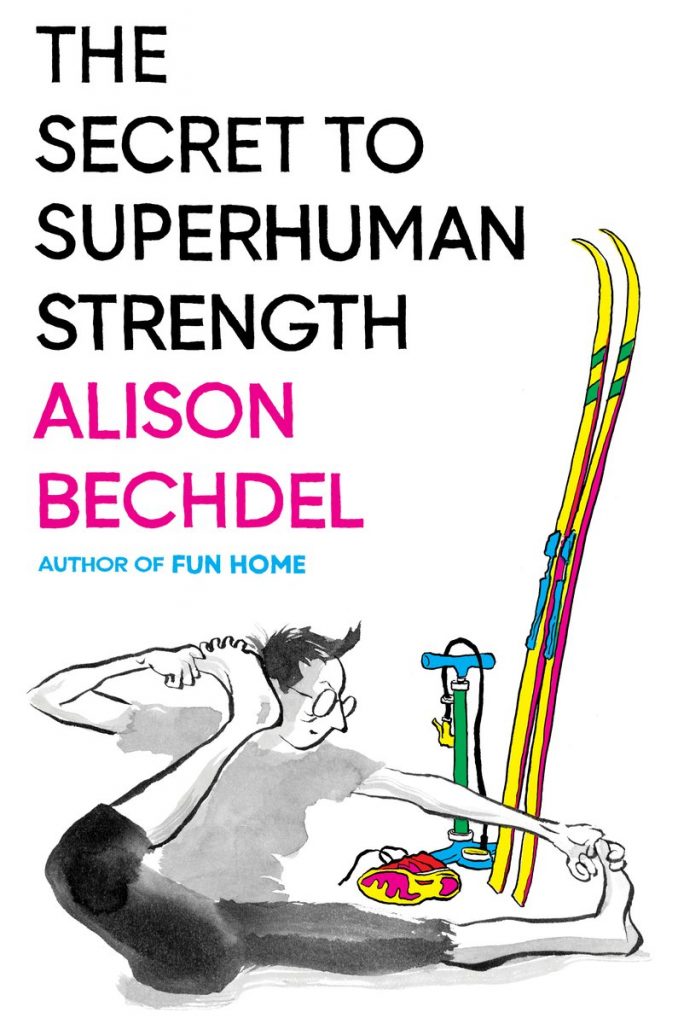
The Surprise Award: The Secret to Superhuman Strength
Everything by Alison Bechdel
I’m not surprised that Alison Bechdel made a great comic. Bechdel is someone who has made a career out of redefining the capability of and esteem in the medium of comics, helping people greater appreciate the “graphic novel” as a proper art form. When you mention graphic novels to people who don’t read them, Fun Home is one they usually can latch onto because it’s an actual crossover success. So, yeah, Bechdel does what Bechdel does here and made a great comic.
What did surprise me – and this might be a hot take – is how much I loved The Secret to Superhuman Strength. This very well might be my favorite work Bechdel has ever done! This tome is, like with her previous work, about Bechdel and her family and life. But it’s more self-focused in many ways, exploring her sense of self and sense of the world through her relationship with fitness and exercise as well as her connection with others throughout history who have found meaning through the physical world. Obviously Fun Home and Are You My Mother? were deeply personal works, but this was the release where I really felt like I got to know Bechdel as a person and a cartoonist.
In the latter regard, the craft in here is truly exceptional, with a playfulness in storytelling and execution that felt enlivened by the cartoonist. Bechdel’s linework and use of washes is as energized as the cartoonist is herself by a good long – long! – run, and it comes across as if she has really let loose in this book, having fun even if there is a ton of anguish in the events within the book. And even then, she still has fun in the sad moments, like in the depiction of herself when a beloved cat passes away, a moment that’s both delivered in amusing and relatably tragic fashion. I could be wilding out here, throwing conjecture out that has no basis in fact. But Bechdel felt energized in this book, and in a way that energized me as a reader.
And in that way, it was a surprise. Great cartoonists making great books isn’t unusual. But great cartoonists finding new gears, like Bechdel did time and time again on what was certainly a deluge of favorite bicycles? That’s special, and I felt it here.
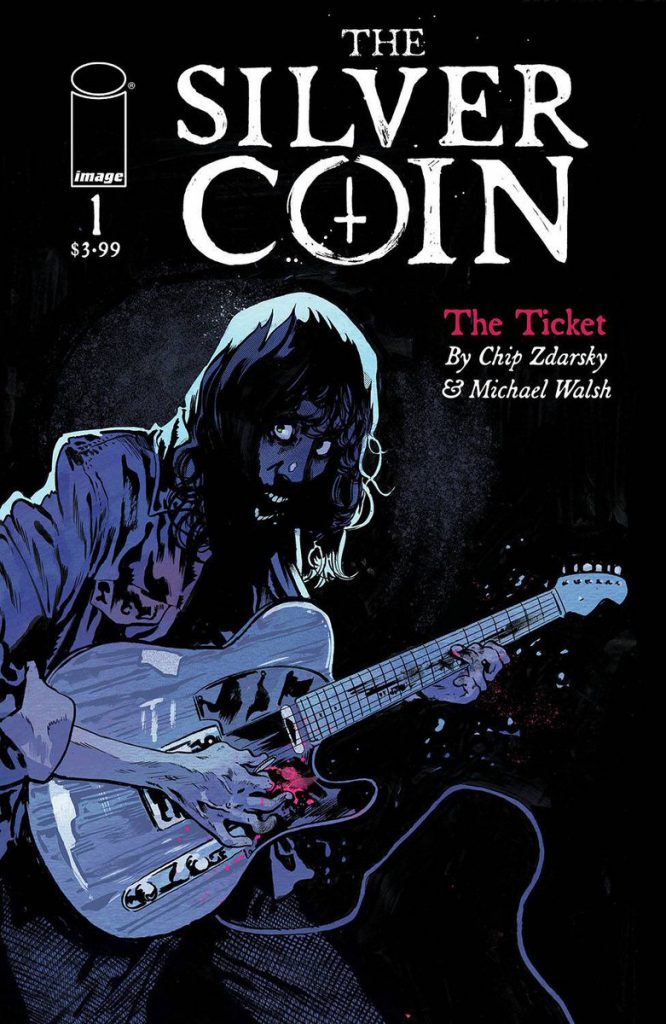
The Features Award: The Silver Coin
Written by Michael Walsh, Chip Zdarsky, Kelly Thompson, Ram V, Jeff Lemire, Joshua Williamson and Ed Brisson
All the art by Michael Walsh
One of the most – and maybe only! – delightful things about this horror anthology is how it inverts the comic book power structure. We are in an era that certainly prioritizes the writer, with comic writers often being analogous for “author” for readers and outsiders. The Silver Coin does everything it can to both feature great writers but also remind people that, hey, artists are important to.
That’s because Michael Walsh – artist, letterer, occasional writer of The Silver Coin – is the impresario of the whole thing. It’s his baby, with his setup – there’s a silver coin that is cursed but impossible to resist, and this is our dark tour through the varying people throughout history that acquire it – being the parameters the talented folks who work on the series operate within. He’s the constant, the showcase artist whose name is always there while writers act as the equivalent of guest rappers who feature on popular tracks. And this sandbox has proven to be a fruitful one, even if I sometimes hate it because it scares me.
Walsh makes it all work. His art establishes the mood and makes everything hit as hard as it does. He’s constantly given new worlds and situations to draw – during the Salem Witch Trials! at casinos! at gigs for going-nowhere bands! in the far future! – and each of them is brought to life in the most effective way possible. More than that, the most potent issue, the aforementioned Salem issue, is one he wrote himself. He’s the tie that binds, and it’s thrilling to see how he features and then elevates his collaborators in exciting ways.
Plus: look at that list of writers. What a murderer’s row! You couldn’t ask for a better mix of talents, and as an outsider, it seems as if they delight in being tourists in this horrific setup Walsh has set up. It’s a fantastic, exciting idea for a book, and one that exceeds its premise with even better execution.
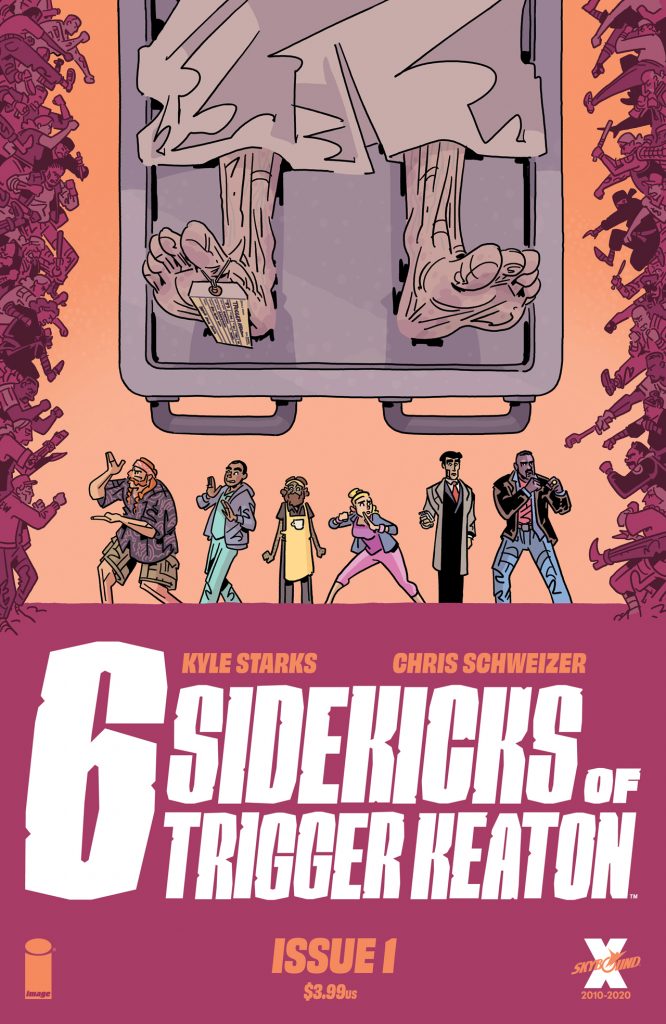
The Best Friends Award: Six Sidekicks of Trigger Keaton
Written by Kyle Starks
Everything else by Chris Schweizer (with color assists by Liz Trice Schweizer)
Being best friends is a powerful thing. For Kyle Starks and Chris Schweizer, that means making great, hilarious comics. For the cast of Six Sidekicks of Trigger Keaton, it means finding kinship – and career opportunities! – in the last place you’d expect thanks to the last person you want to ever support. And for readers of that Image/Skybound series, it means getting to have a hell of a time thanks to the work of the former and the cast of the latter.
Six Sidekicks of Trigger Keaton is a deeply funny, impeccably told, gonzo run through the world of amateur sleuthing, Hollywood has beens, and a much bandied about Stuntman War. It’s a six issue mini-series that also happens to be maybe the funniest comic of the year. But the thing I love most about it is those aspects of friendship, and how it reflects the idea that sometimes the most unexpected people can elevate us to even higher heights.
Starks and Schweizer are both cartoonists, two talented gentlemen of comics who know the types of stories they want to tell and the ways they want to tell them. Even though they’re best buds, collaboration could lead to conflict, both amongst the duo and within the work. But if that conflict was there, it was invisible, as the pair was like steel sharpening steel, an analogy I’m sure Trigger himself (or at least the characters he played) would appreciate or say. All of Starks’ strengths and all of Schweizer’s abilities are pushed upwards thanks to the partnership. Sometimes that manifests itself in amusing details in a room. Other times it’s in a particularly energetic catchphrase being dropped and the electric car chase that follows. If Six Sidekicks was just one of these guys but not the other, it wouldn’t have been the same. Good, but maybe not great, and certainly different.
And then there’s the cast itself. While the premise is great, it’s really the burgeoning, begrudging relationships this crew of titular sidekicks fosters together that connects me to it. While the ultra badass that is Allison Sainte-Marie happens to be my clear favorite, each character gets their moment in the sun, and a realistic path to bonding with their fellow former sidekicks. As they get to know each other and learn how they share more than just a general distaste for their former hero, they get closer to one another, and by the end, it’s just like you’re reading about dear friends of your own. Who fight a lot of stuntmen. And solve one crime.
Six Sidekicks of Trigger Keaton is an absolute delight of a comic, a genuinely funny funny book, and a highlight reel for the power of friendship in a year we could always use one.
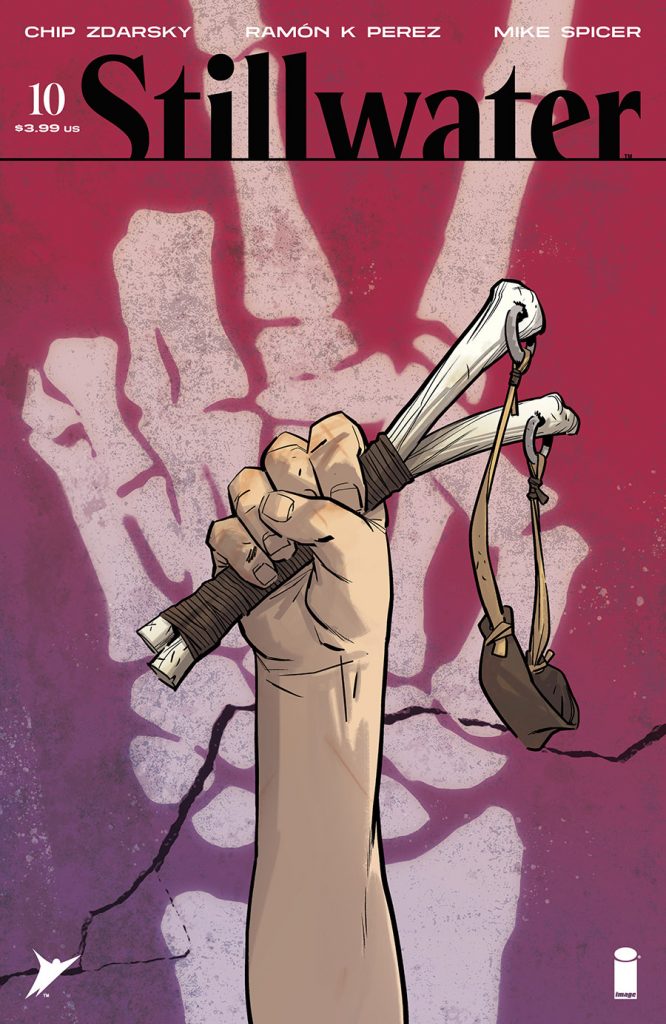
The X Gon’ Give It To Ya Award: Stillwater
Written by Chip Zdarsky
Line art by Ramon Perez
Colored by Mike Spicer
Lettered by Rus Wooton
So, I love this book overall. This Image/Skybound series about the titular town that doesn’t allow anyone within its limits to age or be injured (or, I should say, they can get injured but they heal like Wolverine) or anything adverse really at all save for being oppressed by the town and its leadership is very, very good. It’s one of my favorite comic series going right now. Things are getting crazy within it, and it has just kept getting better and better in 2021.
But the most standout moment from the series in 2021 didn’t even happen in its pages. Instead, it was in Skybound X #2, as that featured a short story from the typical creative team about one of the key characters from the cast and his path to letting go of something important in his life. It was a quick story, but a crushing one, a gut punch of a tale that was an important step for the character and a haunting one about the secret costs of immortality. In this quick, I want to say eight page story, Zdarsky, Perez, Spicer and Wooton completely destroyed and amazed me equally, with it being a brilliant example of what we love about this story and the capabilities of the idea at its core.
It also underlined the values the team has when it comes to what they do with the idea. There’s a lot of bigger, crazier places they could have went with it – I don’t mean that as a plus or a minus, I just mean that as it could have a whole lot more death in it, effectively – but instead, the team never forget just how unusual and creepy and tragic the concept really could be, even if in some ways it might seem utopian in theory. It manifests mostly in the team featuring those who lack control and can’t truly understand what’s happening to them, like one horrifically memorable baby and a particularly tragic cat. Those are the types of residents that a story like this would might typically skip over. These folks don’t, and it’s all the better – and heartbreaking and shocking and haunting – for it.
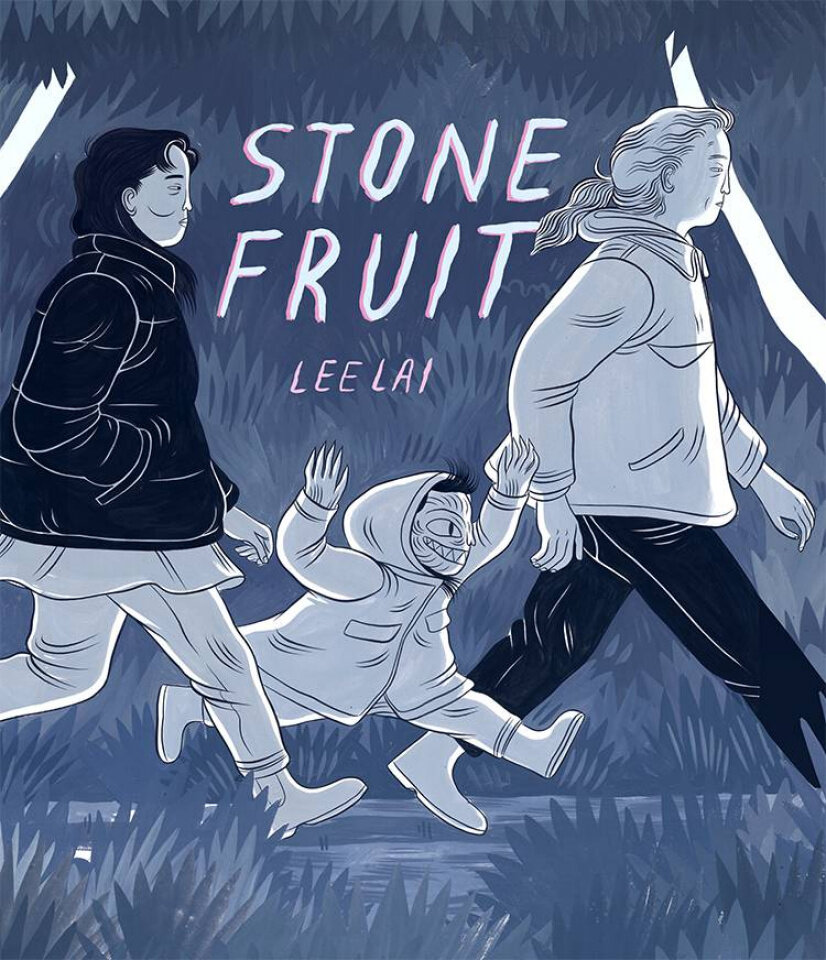
The Connection Award: Stone Fruit
Everything by Lee Lai
Balancing relationships can be tough. It can easily feel like one side gets too much shine or like the other is the villain of the group. So for something like Stone Fruit, Lee Lai’s exemplary graphic novel about the relationship between a queer couple, Ray and Bron, Ray’s disapproving sister Amanda, and her daughter Nessie, the one person amongst them who is loved and loves unequivocally, it can be crucial to find a way to never lean too far in one direction, otherwise our belief in and hope for these relationships to work might erode.
Lai does so impeccably. Even as Amanda seems like an endless grump or Bron leaves Ray to find answers or Ray shuts down because of that action, we never take one side because Lai helps us empathize with and understand what is happening with each character. It’s a sad book filled with sad characters, but Lai’s gifts as a cartoonist connects us as readers to them thanks to the bonds they themselves share. Stone Fruit doesn’t shy away from complicated relationships or complicated feelings; instead it takes them on, head on, and helps us better understand each perspective through that embrace of the situation.
And it’s worth noting that Nessie – the wondrous niece of Ray and Amanda’s daughter – is a ray of sunshine amidst a lot of darkness, helping each character find themselves and find each other again in the process. More than that, she acts as a lighthouse for readers, acting as a joyful balm to the often depressing – understandably so – beats of the story. Lai’s cartooning throughout helps too, especially in the moments Nessie shares with her aunties Ray and Bron, as the cartoonist delivers those beats from a childlike prism of the imaginative play you do as a youth, and some can hold on to as adults. It fosters a connection as well, and builds the connections that form the heart and soul of this excellent graphic novel.
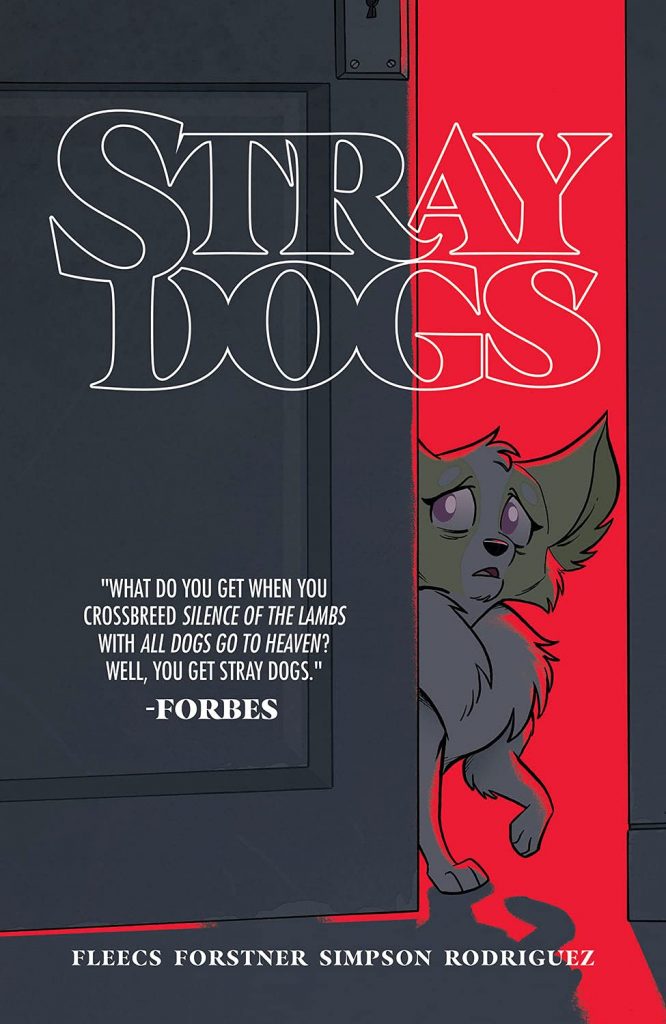
The Good Doggos Award: Stray Dogs
Written by Tony Fleecs
Line art by Trish Forstner
Colored by Brad Simpson
Lettered by Tone Rodriguez
If I’m being honest, I was fully ready to hate this comic. Not because it was bad. But because the idea of animals being harmed is anathema to my very existence. The very idea haunts me, which is why I’ve been cursed to watch roughly 2.5 million videos from The Dodo over the past year, just to be sure that this put upon animal makes it out okay. So Stray Dogs, a comic that’s aptly described as the cross between Silence of the Lambs and All Dogs Go To Heaven on the cover, feels like it just wouldn’t work for me.
And yet, it absolutely did! Its premise – a group of pets have been adopted by a serial killer who killed their respective owners, and it’s about them doing what they can to escape – is brilliant, and its execution mercifully never leads the team down any path of violence for violence’s sake. This is a strong idea, but with well-considered intentions, never pulling punches but also never basking in the danger. It’s about tension more than blood, and it’s better for it.
I suspect one of the main reasons it works, though, is the art team. Trish Forstner is someone whose work I had never come across, and I only knew what she did in this book because of its extremely Don Bluth-like look getting talked up fair bit. Handle it the wrong way and it’s a cheap knock off, making this a high risk move. Forstner doesn’t have any problem with that, though, as she does indeed feel Bluth-like, but at no sacrifice of storytelling. And Brad Simpson’s coloring accentuates that cartoony feel, popping it in a way that fits its roots both in an animation sense and a horror one. It’s perfect.
Stray Dogs walks a fine line. Move too far in one direction and it would have self-destructed, failing completely because of it. But the team of Tony Fleecs, Forstner, Simpson and Tone Rodriguez have no problem with it, nailing the tone and investing us in the cast in the process. It was a great idea with even better execution, as Stray Dogs reached the ceiling of its concept thanks to this exemplary team.
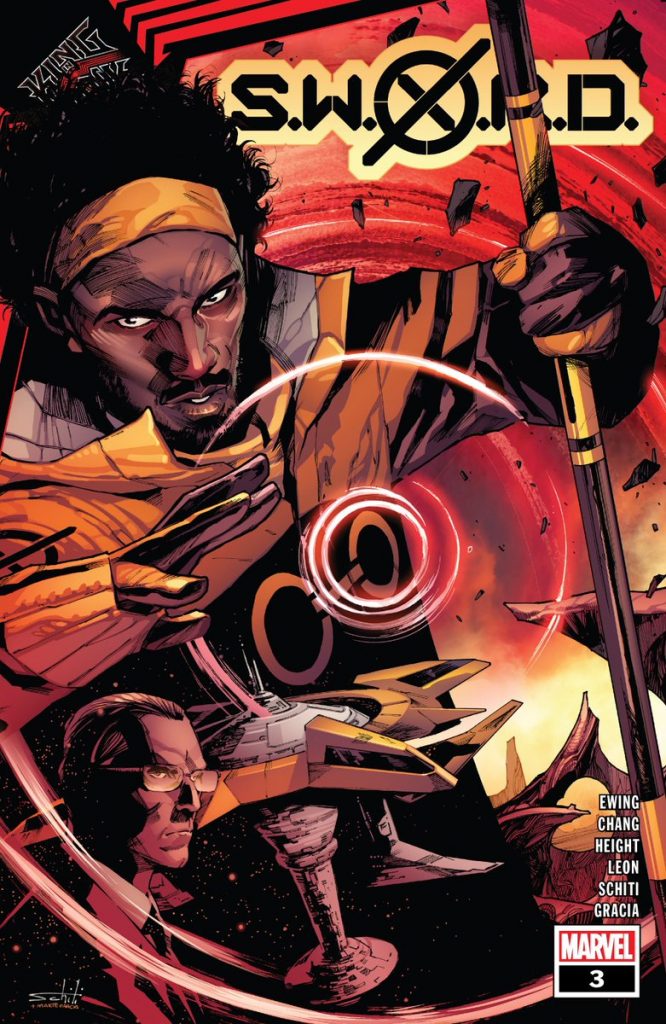
The Making it Work Award: S.W.O.R.D.
Written by Al Ewing
Line art by Valerio Schiti, Stefano Caselli, and more
Colored by Marte Gracia and Protobunker
Lettered by Ariana Maher
Creating in a shared universe like Marvel’s strikes me as a game of balances. You want to serve and even feature the shared universe, otherwise you feel terribly disconnected from the identity of what it does and means. Do so too prolifically, though, and you end up with something that feels like it isn’t a story so much as a tourist of others. That was something S.W.O.R.D. was faced with in its first – and evidently only! – year, as this series had issues that tied into Marvel events/crossovers King in Black, the Hellfire Gala, and The Last Annihilation. Those points of connection can be beneficial, acting as jumping on points for readers, but they can be just as easily jumping off points. That’s a feature and a bug.
Thankfully, Al Ewing is pretty good at this tie-in thing.
S.W.O.R.D. exemplifies that beautifully, with each connection acting as a strength, not a weakness, even if it was one of those situations where it worked, but it might have been better if it didn’t have to. Truth be told, S.W.O.R.D. had all of the big Marvel problems staring it square in the face. Constant tie-ins? Endlessly shifting art teams? Unpredictable release schedules? This title had every excuse to end up being a mess, something Ewing can chalk up to being part of the process of the Marvel Machine. But he and his collaborators made it work, with his lone constant being letterer Ariana Maher, someone who did strong work throughout. That was the theme for the year really: making it work.
But they did, and that’s what mattered. S.W.O.R.D. was an immensely fun, hugely consequential title – Mysterium proved to be a huge beat – with one of the finest single issues of the year in its third issue, a textbook example of how you can make a tie-in work for you with its Manifold focused issue that still connected directly to King in Black. In anyone else’s hands, S.W.O.R.D. wouldn’t have worked. But with this team behind it, the title proved to be a textbook to surviving the rigors of what existing in one of these universes asks of you, even if those same rigors limited its ceiling from great to very good.
I also see my wife and her family in this story, as there’s a lot of overlap between her family and the one in No One Else.↩
